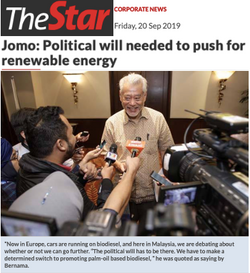- Nov 19, 2024
- 4 min read
Updated: May 16
KUALA LUMPUR, Malaysia, Nov 19 2024 (IPS) - Western financial policies have been squeezing economies worldwide. After being urged to borrow commercial finance heavily, developing countries now struggle with contractionary Western monetary policies.
Central banks
‘Unconventional monetary measures’ in the West helped offset the world economic slowdown after the 2008 global financial crisis.
Higher interest rates have worsened contractions, debt distress, and inequalities due to cost-push inflation triggered by ‘geopolitical’ supply disruptions.
Western central bank efforts have tried to check inflation by curbing demand and raising interest rates. Higher interest rates have worsened contractionary tendencies, exacerbating world stagnation.
Despite major supply-side disruptions and inappropriate policy responses since 2022, energy and food prices have not risen correspondingly. But interest rates have remained high, ostensibly to achieve the 2% inflation target.
Although it has no rigorous basis in either theory or experience, this 2% inflation target – arbitrarily set by the New Zealand Finance Minister in 1989 to realise his “2[%] by ’92” slogan – is still embraced by most rich nations’ monetary authorities!
For over three decades, ‘independent’ central banks have dogmatically pursued this monetary policy target. Once raised, Western central banks have not lowered interest rates, ostensibly because the inflation target has not been achieved.
Independent fiscal boards and other pressures for budgetary austerity in many countries have further reduced fiscal policy space, suppressing demand, investments, growth, jobs, and incomes in vicious cycles.
Debt crises
Before 2022, contractionary tendencies were mitigated by unconventional monetary policies. ‘Quantitative easing’ (QE) provided easy credit, leading to more financialization and indebtedness.
QE also made finance more readily available to the South until interest rates were increased in 2022. As interest rates rose, pressures for fiscal austerity mounted, ostensibly to improve public finances.
Policy space and options have declined, including efforts to undertake developmental and expansionary interventions. Less government spending capacity to act counter-cyclically has worsened economic stagnation.
Comparing the current situation with the 1980s is instructive. The eighties began with fiscal and debt crises, which caused Latin America to lose at least a decade of growth, while Africa was set back for almost a quarter century.
The situation is more dire now, as debt volumes are much higher, while government debt is increasingly from commercial sources. Debt resolution is also much more difficult due to the variety of creditors and loan conditions involved.
Different concerns
With full employment largely achieved with fiscal policy after the global financial crisis, US policymakers are less preoccupied with creating employment.
Meanwhile, the US’s ‘exorbitant privilege’ enables its Treasury to borrow from the rest of the world by selling bonds. Hence, the US Fed’s higher interest rates from 2022 have had contractionary effects worldwide.
As the European Central Bank (ECB) followed the Fed’s lead, concerted increases in Western interest rates attracted funds worldwide.
Western interest rates remained high until they turned around in August 2024. Developing countries have long paid huge premiums well above interest rates in the West.
However, higher interest rates due to US Fed and ECB policies caused funds to flow West, mainly fleeing low-income countries since 2022.
However, growth and job creation remain policy priorities worldwide, especially for governments in the Global South.
Protracted stagnation
Why has world stagnation been so protracted? Although urgently needed, multilateral cooperation is declining.
Meanwhile, international conflicts have been increasingly exacerbated by geopolitical considerations. Increased unilateral sanctions driven by geopolitics have also disrupted international economic relations.
Barack Obama’s ‘pivot to Asia’ started the new Cold War to isolate and surround China. National responses to the COVID-19 pandemic worsened supply-side disruptions.
Meanwhile, the weaponisation of economic policy against geopolitical enemies has been increasingly normalised, often contravening international treaties and agreements.
Such new forms of economic warfare include denying market access despite commitments made with the 1995 establishment of the World Trade Organization.
Trade liberalisation has been in reverse gear since rich nations’ protectionist responses to the 2008 global financial crisis. Globalisation’s promise that trade integration would ensure peace among economic partners was thus betrayed.
Since the first Trump presidency, geopolitical considerations have increasingly influenced foreign direct investments and international trade.
US and Japanese investors were urged to ‘reshore’ from China with limited success, but appeals to ‘friend-shore’ outside China have been more successful.
Property and contractual rights were long deemed almost sacred. However, geopolitically driven asset confiscations have spread quickly.
Financial warfare has also ended Russian access to SWIFT financial transaction facilities and the confiscation of Russian assets by NATO allies.
The Biden administration has extended such efforts by weaponizing US industrial policy to limit ‘enemy’ access to strategic technologies.
It forcibly relocated some Taiwan Semiconductor Manufacturing Corporation operations to the US, albeit with little success.
Canada’s protracted detention of 5G pioneer Huawei founder’s daughter – at US behest – highlighted the West’s growing technology war against China.
Unsurprisingly, inequalities – both intranational and international – continue to deepen. Two-thirds of overall income inequality is international, exacerbating the North-South divide.
Related IPS Articles
Available online here: Western Finance Ruining Economies of the Rest




















